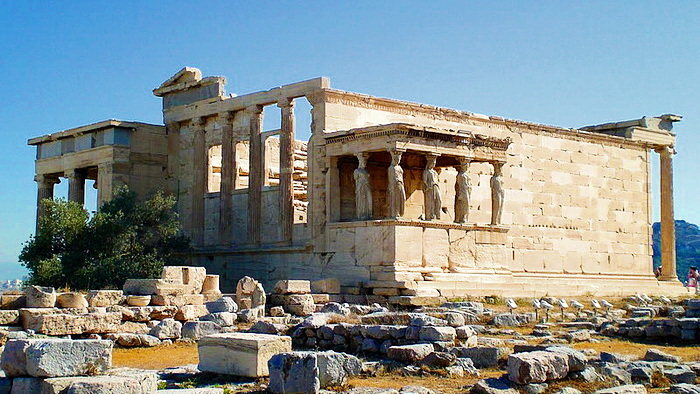The Acropolis’ famed Caryatids, Greece’s most celebrated ancient beauties, are currently undergoing an extreme makeover to clean the century-old statues from pollution, smoke, and whatever else has settled on the statues for over more than a century.
The Caryatid statues, which until the late 1970s propped up a section of the Erechtheion Temple on the Acropolis hill in Athens, are being meticulously cleaned inside the Acropolis Museum where they’re now housed, hence avoiding the potential hazards of moving them, and offering tourists the spectacle of the restoration process.
“We want to offer visitors a backstage peek,” Museum director Dimitris Pantermalis said.
The restoration work, which started in 2011 and is expected to finish in June, is surrounded by a white fabric screen to protect visitors from eye-harming laser beams, as three goggle-wearing conservators use custom-designed lasers to zap away soot and grime from the marble maidens.
“The fact that it was in sight, taking place in the museum, brings home the actual level of care needed to revive them,” an impressed visitor of the museum mentioned. “It’s like cosmetic surgery for statues, isn’t it?”
It takes about seven months to cleanse each of the larger than life-sized statues, which were carved around 420 BC. Conservators use a technology developed especially for the Acropolis sculptures, employing two infrared and ultraviolet wavelengths so as to avoid causing discoloration or abrasion, while leaving intact the patina, that orange hue that the statues took on with the passage of centuries.
“The laser beam hits the black crust formed on the surface of the statues over the years, and that absorbs energy and disintegrates,” head conservator Kostas Vassiliadis mentioned. “The crust has a much lower resistance threshold than the marble, which is not affected.”
One of the six Caryatid figures, removed by Lord Elgin in the early 19th century, is now exhibited in the British Museum in London. The Acropolis Museum houses the other five original figures, which are replaced on-site by replicas.
See all the latest news from Greece and the world at Greekreporter.com. Contact our newsroom to report an update or send your story, photos and videos. Follow GR on Google News and subscribe here to our daily email!




